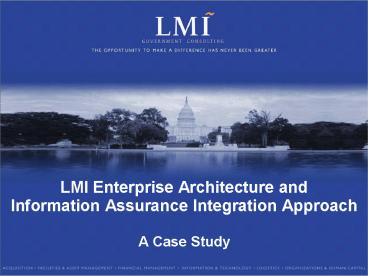LMI Enterprise Architecture and Information Assurance Integration Approach - PowerPoint PPT Presentation
1 / 18
Title:
LMI Enterprise Architecture and Information Assurance Integration Approach
Description:
to bring the best minds to bear on solving our government's most. complex ... in Information Technology from George Mason University and a Master of Science ... – PowerPoint PPT presentation
Number of Views:74
Avg rating:3.0/5.0
Title: LMI Enterprise Architecture and Information Assurance Integration Approach
1
LMI Enterprise Architecture and Information
Assurance Integration Approach
- A Case Study
2
Agenda
- Introduction
- Background/History
- Why Integrate EA and IA
- LMI LEAP Methodology
- Approach to EA IA integration
- Challenges encountered
- Solutions developed
P A G E 2
3
Overview of LMIHistory
Founded in 1961 by Secretary McNamara under the
Kennedy administration to bring the best minds
to bear on solving our governments most complex
management problems
4
Background/History Continued
- LMI is an independent not-for-profit government
consulting firm - Located in McLean, VA
- LMI has substantial experience assisting federal
agencies with IT planning and implementation,
including EA and IA.
5
Background/History Continued
- Dr. Didier Perdu and Dr. Roxanne Everetts
- LMI Research Fellows
- Members of the EA and IA communities of practice
- Dr. Perdu is the EA Practice Technical Advisor
over 20 years experience with EA - Dr. Everetts leads the IA Practice, over 28 years
experience in IT, last 15 in IA
6
Initial Problem
- LMI was asked to developed an IA EA integration
implementation plan - in response to requirements from GAO EAMMF to
capture security aspects in EA - Conducted initial research to establish state of
the practice and identify industry best practice
for integration approach
7
Findings
- Over-estimated maturity of the practice
- IA requirements are not included in EA models and
artifacts - IA has only been routinely integrated into Design
Phase of the System Development Life Cycle (SDLC) - Bottom line
There is limited integration between EA and IA
8
Why integrate EA and IA
- EA can be used to express IA throughout SDLC
- EA provides enterprise-wide coordination and
integration of processes, information, and
technology - EA enables multi-layered analysis of managerial,
technical and operational elements - EA can enable organizations to meet the challenge
of ensuring the optimal allocation of resources
while providing the highest level of security
9
Call to Action
- Based on findings, LMI decided that its EA
approach, LEAP should be modified to integrate IA - In response to increasing requests
- To best serve our government clients
- To align our practice with emerging industry
standards and best practices
10
What is LEAP?
- LMI Enterprise Architecture Practice (LEAP) is
the approach used by LMI since 2000 to help
federal agencies develop and implement Enterprise
Architecture - LEAP perspective is that EA is more than a set of
products required to achieve compliance
Interrelationship of architecture layers
11
LMI EA/IA Integration Methodology
- Focus of IRD project to integrate IA into EA
program - Formed team of EA and IA specialists
- Reviewed existing EA document
- Reviewed IA controls
- Mapped NIST Security controls to EA process
layers - Identified EA products/artifacts to address
controls
12
Challenges Encountered
- No common taxonomy
- Unsure of impact of IA controls on EA artifacts
- Gap between EA process oriented focus and IA
system/technology focused approaches - Lack of Industry Best Practices for integration
approach
13
Solutions Developed
- Extend BPMN to cover process areas where security
controls apply - Bridge gap between process focus vs system focus
- For each IA control, identify changes to related
EA artifacts to address security
14
Solutions Developed Continued
15
Solutions Developed Continued
- Initiate EA and IA staff orientation sessions
- To develop common understanding and taxonomy
- Transform research into best practices
- Reach out to both the EA and IA communities
- Participate in the public discussion
- Share our experience with the community
16
Next Steps
- Normalize LEAP with Federal Segment Architecture
Methodology (FSAM) - Continue to monitor emerging industry standards
and best practices - Continue research and development activities
17
For further information
- Dr. Didier Perdu
- 571-633-7757
- DPerdu_at_LMI.org
- Dr. Roxanne Everetts
- 703-917-7271
- REveretts_at_LMI.org
18
Speakers Bio
- Roxanne B. Everetts, DM, CISSP, CISM, CBCP, is a
Information Assurance Research Fellow at LMI with
over twenty five years of progressively
increasing information technology experience,
including systems administration, database design
and implementation, open systems migration, staff
training and management, and general management
experience. As a Research Fellow at LMI, Dr.
Everetts uses her extensive technical background
to provide high-level support in the areas of
Information Systems Security, Information
Assurance, Information Operations, and Critical
Infrastructure Protection. She provides support
to multiple government agencies, providing
functional and operational expertise analyzing
information security requirements to assist
customers establishing information assurance and
defensive information operations programs. Dr.
Everetts performs extensive research on policy
issues for a variety of customers. - Dr. Didier Perdu is a Research Fellow with LMI
Government Consulting and heads the Tools and
Methods Group of the Enterprise Architecture
Practice. He has more than twenty years of
experience in modeling and evaluation of
enterprise architecture and information systems
using a variety of methodologies and software
packages. Dr. Perdu has worked on many
Enterprise Architecture projects for government
clients such as GSA, OMB, US Army, CMS, and GPO.
Dr Perdu holds a Ph.D. in Information Technology
from George Mason University and a Master of
Science in Technology and Policy from MIT.































